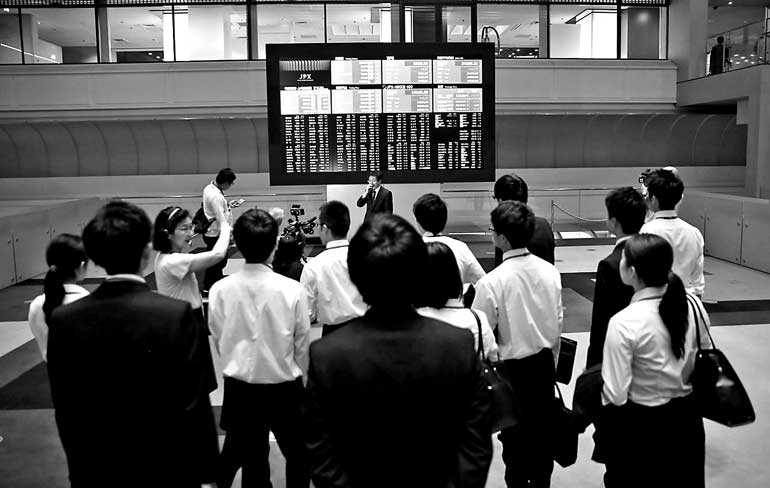Wednesday Dec 03, 2025
Wednesday Dec 03, 2025
Saturday, 12 January 2019 00:00 - - {{hitsCtrl.values.hits}}

Visitors look at an electronic stock quotation board at the Tokyo Stock Exchange (TSE) in Tokyo, Japan - Reuters
TOKYO (Reuters): Asian stocks inched up to five-week highs on Friday, after Chairman Jerome Powell reiterated the Federal Reserve will be patient about raising interest rates and news that trade talks between Washington and Beijing are moving to higher levels.
As the Fed’s dovish stance kept a lid on the dollar, China’s yuan rose to its highest levels in more than five months and was on course for its biggest weekly gains since the 2005 revaluation in onshore trade.
European shares are expected to rise, and financial spread-betters expect Britain’s FTSE, France’s CAC, Germany’s DAX to tick up 0.1 - 0.2%.
MSCI’s broadest index of Asia-Pacific shares outside Japan gained 0.29% to the highest levels since Dec. 6, while Japan’s benchmark Nikkei .N225 advanced 0.97%. Shanghai Composite Index initially rose 0.56%.
Wall Street extended its rally into a fifth straight day on Thursday in a whipsaw trading session as investors responded to mixed comments by Powell, while a warning from Macy’s pummeled retail stocks.
At the Economic Club of Washington, Powell reiterated the views of other policymakers that the Fed would be patient about interest rate hikes.
Major U.S. stock indexes also quickly recovered from brief losses after Powell said that the Fed’s balance sheet would be “substantially smaller”.
“The word ‘patient’ is used often when the Fed’s policy direction is still tightening but its next rate hike can wait for a considerable time. So risk assets now enjoy support from what we can call Powell put,” said Tomoaki Shishido, economist at Nomura Securities.
The term “Powell put” refers to the idea that Powell’s policy will protect investors from falls in share prices, much like put options, or rights to sell assets at a pre-determined price.
Investors who worry about a fall in equity prices often buy their put options for hedge.
“Similarly, Trump also softened his stance on China after sharp falls in stock prices. He has offered an olive branch to China and there’s no reason China would not want to accept it,” he said.
US and Chinese officials are working on arrangements for higher-level trade talks after mid-level officials this week discussed US demands that would require structural change in China to address issues such as IP theft, forced technology transfers and other non-tariff barriers.
US Treasury Secretary Steven Mnuchin said Chinese Vice Premier Liu He will “most likely” visit Washington later in January for trade talks.
“For markets the upshot is that the outlook for 2019 is looking better as tensions de-escalate, creating the potential for a re-rating of risk assets as the tail risk of a near-term trade war is partially priced out,” said Jeremy Lawson, chief economist at Aberdeen Standard Investments in Edinburgh.
“This is especially the case in Asia,” he added.
Still, fundamental tensions between the US and China “are unlikely to go away and there is a high likelihood that any agreement to suspend tariffs eventually breaks down when it becomes clear that Trump’s objectives cannot really be met.”